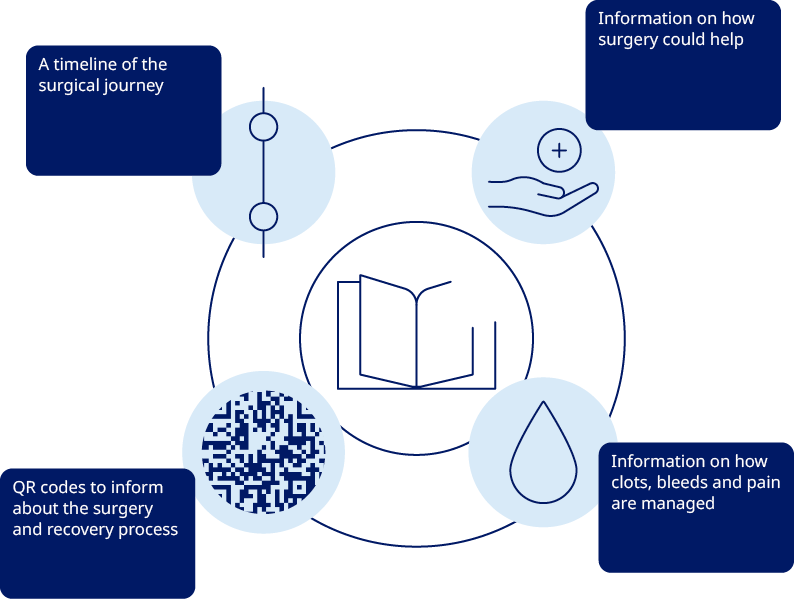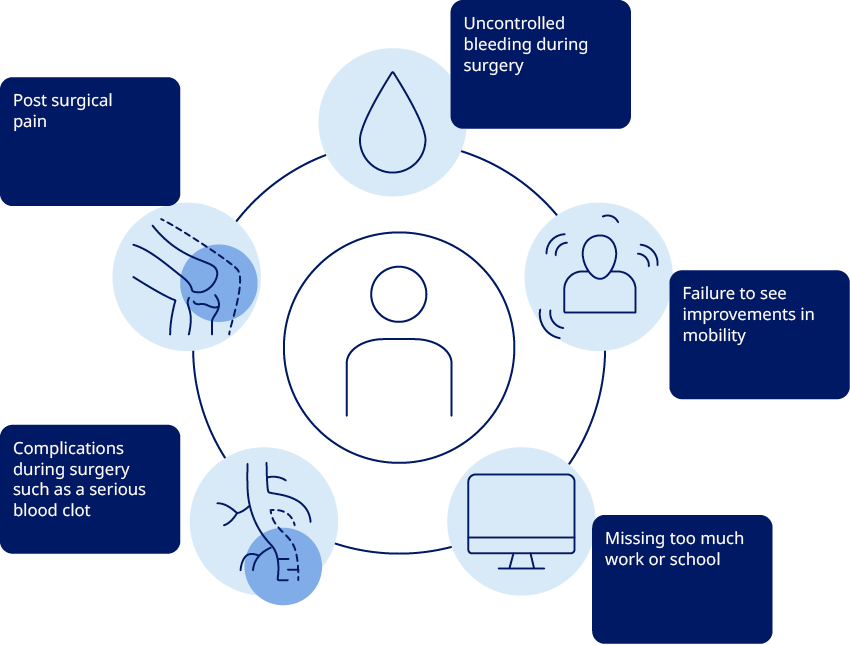
DISEASE AREA
Elective orthopaedic surgery (EOS) in inhibitor patients
In patients with severe haemophilia and in particular inhibitor patients, joint haemorrhage makes up more than 80% of bleeding episodes (mainly elbows, knees and ankles),1 and many patients will develop one or more ‘target joints’ that carry an increased risk of recurrent bleeds.2
Recurrent haemarthroses in target joints may evolve over years towards chronic arthropathy with cartilage damage, the narrowing of joint space and, ultimately, bone deterioration.2 The development of arthropathy is one of the most common and debilitating clinical manifestations of haemophilia, leading to complications such as joint pain and reduced joint mobility.2,3
EOS can offer potential benefits for patients, improving health-related quality of life and reducing pain and discomfort.4 Advances in treatments and orthopaedic surgery mean that EOS procedures can even be considered in complex cases, however, some patients’ barriers to undergo EOS remain.5-7
Advances in treatment, combined with advances in orthopaedic surgery means that orthopaedic surgical procedures can be considered, even in the most complex cases.8 In patients with inhibitors, EOS will require more careful preparation and should only be undertaken by a multidisciplinary team (MDT) experienced in this area, at a specialised haemophilia treatment centre with a comprehensive care model.9
"The aim of this checklist is to help you assess whether your patient with haemophilia needs further investigations and/or referral to evaluate whether they could benefit from EOS. Use this checklist regularly to assess the status of any joint that is causing concern to you or your patient, and to monitor whether there has been a change in the status. Please see overleaf for a description of this tool and what it can – and cannot – do."
Who is this material for?
The checklist is for use by non-specialist healthcare professionals as a starting point for further discussions with the wider specialist multidisciplinary team.
When should it be used?
Before and during initial consultaion
Getting the conversation started around EOS is a big hurdle for both healthcare professional (HCP) and patient. The ‘conversation starter tool’ has been developed to guide you through the initial EOS discussion with your patient, to help them make an informed decision.
The tool will assist the MDT in initiating discussions with suitable patients about surgery during routine follow-up appointments; providing patients with an overview of EOS, any associated risks, as well as providing information about the pre, peri and post-operative period. The information is visual and can be downloaded.
Who is this material for?
HTC-HCP and surgeons
When should it be used?
Routine follow-up appointments

During the initial surgical discussion, patients may struggle to picture what their surgical journey will look like, and what the steps may be. The ‘EOS journey guide’ can be given to your patients to help them become more informed. This downloadable brochure will help your patients understand what to expect from the EOS journey.
The optimal timing of EOS during the lifetime of a person with haemophilia is a matter of debate. While advanced procedures, particularly joint replacement, may be more appropriate for patients who have completed growth, there are arguments in favour of surgery in younger patients: younger people can benefit from interventions earlier in life and are more easily rehabilitated.10
Assessing whether a patient is eligible for surgery involves an MDT approach and assessment of the level of arthropathy. Following the initial conversation, you may determine that the patient could be a candidate for EOS.
The ‘planning tool’ can be used by the specialist nurse during a pre-surgery appointment and then handed to the patient.
The patient planning tool is a downloadable brochure which focuses on key information about their surgery. It includes an additional discussion guide for assessment of readiness for surgery (for the patient to complete) and a pain management plan (which the patient should complete alongside their physiotherapist).
Who is this material for?
Nurse will discuss and then hand to the patient
When should it be used?
Appointment to discuss considerations before and after surgery
Before you and your patient make the decision to go ahead with EOS, it is important that they understand all of the facts.
With that in mind we have developed the ‘patient counselling tool’, to help guide a discussion around the potential benefits and risks of surgery and any concerns that your patient may have. This material has been designed for use in conjunction with the MDT (physician, surgeon, and specialist nurse).
Who is this material for?
Nurses
When should it be used?
Follow-up with patients who are considering surgery
Preparing for EOS can be a busy and stressful time for the patient, involving many different members of the MDT. Patient’s may have a number of concerns and question pre-, peri- and post-surgery.
We have developed the ‘surgery support brochure’ to help guide and facilitate key discussion points to help address specific surgery-related questions. The planning tool takes the form of a 4-page brochure and discusses before surgery, key preparation points in the months leading up to surgery, the post-surgery hospital stay and beyond.
Who is this material for?
Surgeons
When should it be used?
Preparatory meeting with surgeon before surgery
Pre- and post-operative physiotherapy are essential to optimise the outcomes of EOS and physiotherapists play a vital role before and after surgery. The ‘surgery recovery guide’ was created to be used by physiotherapists during consultations with the patient, to help the patient understand the recommended physiotherapy programme. It discusses physiotherapy before surgery, after surgery and then how to set appropriate/achievable goals which should be specific for the patient.
Who is this material for?
Physiotherapists
When should it be used?
Meeting with patients to discuss rehabilitation
Rodriguez-Merchan EC, et al. Haemophilia 2011;17:1–23.
Knobe K & Berntorp E. Journal of Comorbidity 2011;1:51–59.
Lobet S, et al. J Blood Med 2014;5:207–18.
Canadian Hemophilia Society. A Guide on Orthopedic Surgery for People
with Hemophilia.
Available from: https://www.hemophilia.ca/files/Challenges-Choices-Decisions%20Hemophilia.pdf
[Last accessed January 2021].
Rodriguez-Merchan EC, et al. Haemophilia 2007;13,613–619.
Srivastava A, et al. Haemophilia 2014;19:e1– e47.
DeKoven M, et al. J Med Econ 2012;15:305–312.
Rodríguez-Merchán EC. EFORT Open Rev 2019;4:165–173.
Escobar MA, et al. Haemophilia. 2018;24:693–702.
Ingerslev J, Hvid I. Semin Hematol 2006;43:S23–6.

